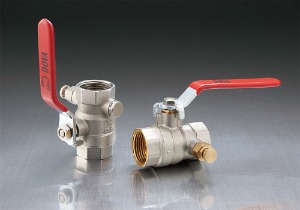2025-10-10
Brass ball valves factory are widely used in plumbing, industrial, and mechanical systems due to their reliability, corrosion resistance, and ease of operation. They allow precise control of fluid flow and are available in a variety of sizes and types to suit different applications.

Common Sizes of Brass Ball Valves
Brass ball valves come in a range of sizes to accommodate different pipe diameters and flow requirements. The common sizes include small diameters, such as 1/4 inch and 1/2 inch, typically used in residential plumbing and household water systems. Medium sizes, like 3/4 inch and 1 inch, are often employed in commercial and light industrial applications. Larger sizes, including 2 inches and above, are suitable for industrial pipelines and systems with higher flow demands. Manufacturers also offer customized sizes for specific projects, ensuring that Brass Ball Valves can meet diverse operational requirements.
Full Port vs. Standard Port Valves
One of the basic distinctions among Brass Ball Valves is between full port and standard port designs. Full port valves have a bore that is the same diameter as the pipeline, pressure drop and allowing flow. They are commonly used in systems where maintaining high flow efficiency is critical. Standard port valves, on the other hand, have a slightly smaller bore, which can cause a minor pressure drop but are generally more compact and cost-effective. Understanding the difference helps in selecting the appropriate valve based on system requirements and flow conditions.
Two-Way and Three-Way Valves
Brass Ball Valves are also categorized by their flow configuration, commonly as two-way or three-way valves. Two-way valves are the simplest type, allowing fluid to flow in one direction or to be completely shut off. They are widely used for straightforward on/off applications in both residential and industrial systems. Three-way valves have three ports and can direct flow between multiple pipelines, making them suitable for mixing or diverting applications. These valves are commonly used in heating systems, chemical processing, and complex plumbing networks.
Threaded, Socket, and Flanged Connections
Another way to classify Brass Ball Valves is by their connection type. Threaded valves have internal or external threads and are easy to install in small to medium pipelines, making them common in household and light industrial settings. Socket weld valves are designed to be welded to pipes, providing a more permanent and leak-resistant connection suitable for higher-pressure systems. Flanged valves feature flanges at each end, allowing for bolted connections in large pipelines and industrial applications. Selecting the right connection type ensures compatibility with the piping system and simplifies installation and maintenance.
Specialty Brass Ball Valves
In addition to standard sizes and configurations, there are specialty Brass Ball Valves designed for specific functions or environments. These may include valves with extended handles for easy operation in hard-to-reach areas, valves with lockable handles for safety purposes, or valves with enhanced seals for high-temperature or chemical-resistant applications. Specialty valves demonstrate the adaptability of Brass Ball Valves to meet the demands of different industries, including water treatment, HVAC systems, and manufacturing processes.
Brass Ball Valves offer a versatile and reliable solution for controlling fluid flow in a wide range of systems. Their sizes vary from small residential diameters to large industrial pipelines, while their basic categories include full port and standard port designs, two-way and three-way configurations, and various connection types such as threaded, socket, and flanged. Additionally, specialty Brass Ball Valves address specific operational needs, further enhancing their usefulness across different industries. Understanding these sizes and categories is essential for selecting the right valve, ensuring efficient and safe fluid management in any application.